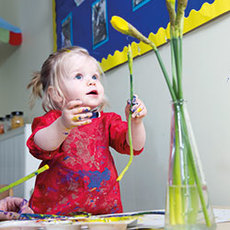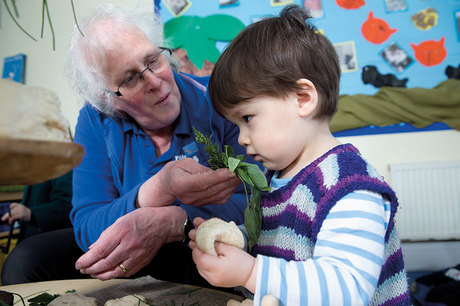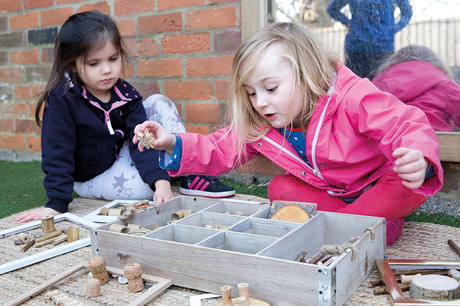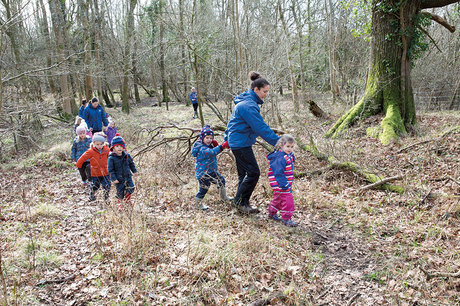
Froebel was very familiar with nature. He spent much of his early childhood in the garden, and later in his youth he learnt forestry.
His mother died before his first birthday, and his stepmother, once she had a baby of her own, sent him to the garden where he spent a lonely time. His father was a strict pastor, whose relationship with his son was distant and disciplinarian. Therefore Froebel did not experience the family warmth and affection that he yearned for and later made central in his approach to the education of babies and young children. Fortunately during middle childhood, Froebel’s uncle offered him a home where he felt loved and where his need to be with nature was encouraged.
Helen Tovey emphasises that just spending time out of doors in nature is not enough. She reminds us that Froebel was of the view that if children do not find adults who actively engage with it, ‘the seed of knowledge just beginning to germinate is crushed’. In other words, we can’t expect children to understand how nature works and what is important about it if the adults who spend time with them don’t have that commitment to its fundamental importance for humanity.
Engagement with nature is of central importance to Froebel because it gives, in a concrete and tangible way, the possibility to understand concepts which are quite abstract, such as seasonal changes, the phases of the moon, looking at stars, flocks of birds and their flight, or the source of a stream that becomes a river and flows to the sea, and now, climate change. Nature introduces children to the patterns and processes of life and death, to transformations – such as frogspawn to frogs or caterpillars to butterflies – and the beauty that brings fulfilment and well-being.
UNITY
 Froebel developed his thinking about ‘Unity’ using nature as a central vehicle to do so. This means he saw how everything in the universe connects. Understanding and interacting with nature gives a balance and stability to what is symbolic and what is real. The Gifts, Occupations, Mother Songs, Movement Games and Play give children rich ways to draw on what is real and use it as a resource. They can use what they have experienced to make and remake meaning. This constant to and fro between what is real and what is symbolic (or pretend) fosters the creativity of the child, and there is connection between the ‘inner and the outer life’.
Froebel developed his thinking about ‘Unity’ using nature as a central vehicle to do so. This means he saw how everything in the universe connects. Understanding and interacting with nature gives a balance and stability to what is symbolic and what is real. The Gifts, Occupations, Mother Songs, Movement Games and Play give children rich ways to draw on what is real and use it as a resource. They can use what they have experienced to make and remake meaning. This constant to and fro between what is real and what is symbolic (or pretend) fosters the creativity of the child, and there is connection between the ‘inner and the outer life’.
But it is not uncommon in early childhood settings to see outlines of daffodils drawn by adults, with tips of egg cartons cut by adults which children are then ‘helped’ to stick on and paint yellow, and for these to be put onto an adult-created collage scene of ‘spring’. For the child who has never planted a daffodil bulb, this is not going to mean much at all. There is no understanding or engagement with nature in this activity either for the child or the adult. Both need to engage with nature, or they won’t understand it.
Chris Athey and Tina Bruce, in the internationally recognised Froebel Nursery Research School, found that about three-quarters of the things children chose to represent, in a variety of ways with a rich range of different materials, were experiences they had actively taken part in at the school and what parents reported from home. The richer the experiences of the child, the greater are the resources for the inner life to create symbolic representations.
PROBLEM-SOLVING
The symbolic life of the child is important, but so is problem-solving. Children who engage with nature are inevitably faced with problem-solving. How can the plant stay upright so that it is not knocked down by the wind? Tying the plant to a stick often solves it.
Planting presents a variety of challenges which children readily participate in when adults support them by providing suitable equipment and cards to help them sequence the steps they must take. Their understanding can be extended by providing appropriate books, often best enjoyed and reflected on after the experience. An example would be the wonderful series of Clue Books by Gwen Allen and Joan Denslow, created in the late 1960s and continually reprinted since then. Also, don’t overlook the deep joy gained from eating carrots grown in the garden.
PHYSICAL DEVELOPMENT
Being outside and interacting with nature encourages symbolic behaviour and problem-solving. It also encourages physical development, such as climbing trees. Molly Brearley, who was principal of the Froebel Educational Institute, used to advise her students that children only need climbing frames when they can’t climb trees and rocks.
Through spending time out of doors as a child, Froebel discovered the enjoyment of being there. It is equally important that adults, as well as children, wear suitable clothes so they are comfortable and committed to spending time outside, engaging in nature and encouraging climbing and outdoor possibilities for physical movement. Froebel encouraged den-making and cooking out of doors, as well as singing and dancing round the fire. There is the possibility to develop a strong sense of being part of a community when singing around a fire and sharing food together.
Froebel’s favourite colour was green – the colour of nature. A flower he loved was the lily, which can grow in dark and dank places where you would not expect to find anything beautiful. His inclusive approach to the education of young children meant he believed the lily was symbolic of the way children can flourish if they are given the right help in the right way and at the right time for their development, wherever they are growing up and whoever they are.

IN PRACTICE
How Yellow Dot Nurseries is enabling children to explore nature. By Jane Dyke
Froebel created the first kindergarten, translated literally from German as ‘children’s garden’. It was a place ‘where children could develop at their own pace, nurtured by knowledgeable and supportive adults’. Helen Tovey led our session on the outdoors and stimulated our thoughts on ‘Risk’, ‘Playing in Nature’, ‘Playing bravely and boldly’ and developing a place where children can develop respect and responsibility for nature.
It made us question what opportunities we were giving our children. Ms Tovey says ‘a Froebelian garden is seen as a rich learning environment, which can complement and link with the indoor area but which also offers unique learning experiences which cannot be provided indoors’.
ON REFLECTION
Froebel says ‘one should start where the learner is’. We are lucky enough to have reasonable-sized gardens, so we immediately started to observe what was actually happening within them.
What we found was that we had a surprising amount of fairly boring plastic toys that were not well-utilised (interestingly, no-one remembered buying them). We also found that we spent quite a bit of time ‘setting up’ the gardens each day and then packing away. On reflection, this was because much of the equipment and toys that we had were not outdoor-friendly and so had to be stored.
Following these observations, we decided to declutter our gardens using the ‘less is more’ principle. We tried to take everything out of the gardens that did not really belong in a garden. Our ultimate aim was not to have to set up the garden but instead have a garden that is natural and/or outdoor-friendly.
TAKING RISKS
Having decluttered, we looked at what opportunities there were for playing and exploring, active learning and creating and thinking critically.
A Froebelian approach encourages opportunities for positive risk-taking and adventurous play outdoors. Froebel argued that children who have experienced risk and challenges in their play were safer than those who had been protected and discouraged from challenging themselves. He said, ‘To climb a tree is… to discover a new world; seen from above, every­thing looks quite different… a child who lacks experience will not know his own capabilities and is more likely to encounter danger.’
So we also investigated what opportunities our gardens were providing for ‘Risk taking’.
Ms Tovey in her book Bringing the Froebel Approach to your Early Years Practice advocates providing open-ended materials, play props and ‘loose parts’, as well as support from adults who value such play so that children can create their own ‘imaginary world’. We realised that the toys and equipment that we were providing were not very open-ended. So now crates, planks, ladders, outdoor blocks, builders’ trays, guttering, stones, sticks, branches, tractor tyres and planters have replaced our boring plastic toys. We have found that pallets are the king of recycling. They can easily be transformed into climbing towers, flower boxes, tool storage and mud-kitchen shelving.
I have to say that from a practitioner point of view, this was not an easy change for all of us. Some of us are deeply suspicious of more risky play, and we are still on a journey to find the balance.
COMMUNITY
After starting with our gardens we then looked outside into the community. Froebel said that, ‘Teachers should regularly take their classes out of doors – not driving them like a flock of sheep or leading them like they were a company of soldiers.’ When we heard this we nervously laughed, somewhat embarrassed. It may be 250 years later, but we could all too easily imagine a similar sight.
Some of our nurseries were regularly accessing places of interest in the community. We find this energises and enthuses not just the children but the team too. Language and communication is incredibly enhanced by such trips, and engagement with parents is also enhanced as the children are keen to tell of their adventures. Slowly, over time, we have become less attached to our ‘walking rings’ and, when appropriate, we are now walking alongside our children and interacting as family, rather than regiments.
Every nursery now has the opportunity to access what we call the ‘third space’. This is a place where children can authentically ‘play in nature’, experience risk, play boldly and bravely. We have engaged with local Forest Schools and developed our own Nature Nursery, where we bus our children to spend the whole day ‘playing in nature’. Pre-Froebel training, we would have probably accessed these spaces a few times a year, but now they are at least a weekly excursion. Through this our children are developing their collaboration skills and managing and assessing risk. The children and team are also being helped to overcome their fears.
Froebel has opened up the outdoors to us and it has now become a rich learning environment that is developing with the seasons.
Real life: Getting digging
We talked to the children about the changes we were making. In one nursery, the children asked if they could have a sand pit in the garden. Pre-Froebel training, I would have arranged for the handyman or contractors to come in and build a sandpit, but Froebel’s Forms of Life, Knowledge and Beauty (see Part 1 of our series in Nursery World, 23 January) are now ringing in my ears along with Freedom with Guidance. So I asked the kindergarten team to talk to the children and plan how we would do this from their experiences.
The children said that we needed real spades to dig a deep hole to fill with sand, so we bought real tools for the children to dig their sand pit. The ground was pretty hard so we discussed with the children what we could do. They decided to make the ground wet so that it would be muddy and easier to dig. The team joined in too and occasionally forked over the soil to make things a little easier. We bought a trailer to transport the earth to the flower beds and used lots to build up the sides.
Frequently construction would stop as a worm was discovered, excavated and rehomed. A whole week went by as ants were studied. The sand pit project started in August and is still not finished – the hole has grown and become many things in the past six months. I would never have believed that having a large hole in the garden could be a thing of beauty – but it is!
Froebel was very keen for children to understand how ‘real life’ worked, how people had skills and occupations and how we are all interconnected. Digging our own sand pit is helping the children to appreciate the different roles that we have and the need for specific tools to make tasks easier, for skill and strength and perseverance.
MORE INFORMATION
Allen G and Denslow J (1960s) Clue Books series of nature books
Bruce T (2012) Early Childhood Practice: Froebel Today. Sage
Bruce T (2015) Early Childhood Education. 5th edition. Hodder Education
Tovey H (2017) Bringing the Froebel Approach to Your Early Years Practice. 2nd edition. Routledge
ABOUT THIS SERIES
This six-part series aims to:
- convey Froebel’s continuing importance as an early years educator and thinker
- make links between the EYFS and Froebel’s principles and approach to early development and learning
- demonstrate ‘Froebel in action’ at Yellow Dot nurseries, Hampshire, which piloted training courses designed to help PVI settings embrace the Froebelian approach.
Co-written by Froebelian expert Professor Tina Bruce and Yellow Dot founder and owner Jane Dyke, the six articles will cover:
- the Gifts
- the Occupations
- the place of nature in learning
- the symbolic life of the child
- the importance of nurture
- self-discipline rather than extrinsic motivation.
Linked to the series is a set of posters produced in association with Community Playthings (www.communityplaythings.co.uk), which will be taking part in this year’s bicentenary celebrations of the founding of Froebel’s school in Keilhau, Germany.









